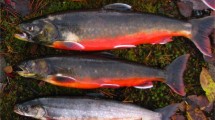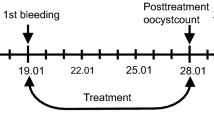Abstract
The Hamilton-Zuk hypothesis proposes that the bright colours displayed by many species of birds serve as signals of individual resistance to parasites. Despite the popularity of this hypothesis, only one previous study has tested whether plumage coloration predicts how individuals respond to a disease challenge. We inoculated 24 male house finches (Carpodacus mexicanus) of variable plumage hue with a novel bacterial pathogen, Mycoplasma gallicepticum (MG). We found no relationship between plumage hue and time to first symptoms following inoculation, but we found a significant negative relationship between plumage hue and clearance of disease: males with redder plumage cleared MG infection significantly better than did males with yellower plumage. The hue of carotenoid-based plumage coloration has been shown to be a primary criterion in female mate choice in the house finch. These observations suggest that one benefit to females for choosing redder males is obtaining mates with better resistance to parasites.


Similar content being viewed by others
References
Andersson M (1994) Sexual selection. Princeton University Press, Princeton, N.J.
Blount J, Metcalfe N, Birkhead T, Surai P (2003) Carotenoid modulation of immune function and sexual attractiveness in zebra finches. Science 300:125–127
Brawner WR, III, Hill GE, Sundermann CA (2000) Effects of coccidial and mycoplasmal infections on carotenoid-based plumage pigmentation in male house finches. Auk 117:952–963
Dhondt AA, Tessaglia DL, Slothower RL (1998) Epidemic mycoplasmal conjunctivitis in house finches from eastern North America. J Wildl Dis 34:265–280
Duckworth RA, Badyaev AV, Farmer KL, Hill GE, Roberts SR (2003) First case of mycoplasmosis in the native range of the house finch (Carpodacus mexicanus). Auk 120:528–530
Eley C (1991) Status signalling in the western greenfinch, Carduelis chloris. PhD thesis, University of Sussex, Brighton, U.K.
Farmer KR, Hill GE, Roberts SR (2002) Susceptibility of a naive population of house finches to Mycoplasma gallisepticum. J Wildl Dis 38:261–265
Folstad I, Karter AJ (1992) Parasites, bright males, and the immunocompetence handicap. Am Nat 139:603–622
Gonzalez G, Sorci G, Møller AP, Ninni P, Haussy C, de Lope F (1999) Immuncompetence and condition-dependent sexual advertisement in male house sparrows (Passer domesticus). J Anim Ecol 68:1225–1234
Hamilton WJ, Poulin R (1997) The Hamilton and Zuk hypothesis revisted: a meta-analytical approach. Behaviour 134:299–320
Hamilton WD, Zuk M (1982) Heritable true fitness and bright birds: a role for parasites? Science 218:384–386
Hill GE (1990) Female house finches prefer colourful males: sexual selection for a condition-dependent trait. Anim Behav 40:563–572
Hill GE (1991) Plumage coloration is a sexually selected indicator of male quality. Nature 350:337–339
Hill GE (1992) Proximate basis of variation in carotenoid pigmentation in male house finches. Auk 109:1–12
Hill GE (1993) Geographic variation in the carotenoid plumage pigmentation of male house finches (Carpodacus mexicanus). Biol J Linn Soc 49:63–86
Hill GE (1994) Geographic variation in male ornamentation and female mate preference in the house finch: a comparative test of models of sexual selection. Behav Ecol 5:64–73
Hill GE (1998) An easy, inexpensive method to quantify plumage coloration. J Field Ornithol 69:353–363
Hill GE (2000) Energetic constraints on expression of carotenoid-based plumage coloration. J Avian Biol 31:559–566
Hill GE (2002) A red bird in a brown bag: the function and evolution of ornamental plumage coloration in the house finch. Oxford University Press, New York
Hill GE, Montgomerie R (1994) Plumage colour signals nutritional condition in the house finch. Proc R Soc Lond B 258:47–52
Hill GE, Nolan PM, Stoehr AM (1999) Pairing success relative to male plumage redness and pigment symmetry in the house finch: temporal and geographic constancy. Behav Ecol 10:48–53
Hill GE, Inouye CY, Montgomerie R (2002) Dietary carotenoids predict plumage coloration in wild house finches. Proc R Soc Lond B 269:1119–1124
Hill GE, Farmer KL, Beck ML (2004a) The effect of micoplasmosis on carotenoid plumage coloration in male house finches. J Exp Biol 207:2095–2099.
Hill GE, Doucet SM, Buchholz R (2004b) The effect of coccidial infection on iridescent plumage coloration in wild turkeys. Anim Behav (in press)
Inouye CY (1999) The physiological bases for carotenoid color variation in the house finch, Carpodacus mexicanus. PhD thesis, University of California, Los Angeles, Calif.
Ley DH, Berkhoff JE, McLaren JM (1996) Mycoplasma gallisepticum isolated from house finches (Carpodacus mexicanus) with conjunctivitis. Avian Dis 40:480–483
Lindström K, Lundström J (2000) Male greenfinches (Carduelis chloris) with brighter ornaments have higher virus infection clearance rate. Behav Ecol Sociobiol 48:44–51
Lozano GA (1994) Carotenoids, parasites, and sexual selection. Oikos 70:309–311
McGraw KJ, Ardia DR (2003) Carotenoids, immunocompetence, and the information content of sexual colors: an experimental test. Am Nat 162:704–712
McGraw KJ, Hill GE (2000) Differential effects of endoparasitism on the expression of carotenoid- and melanin-based ornamental coloration. Proc R Soc Lond B 267:1525–1531
Møller AP, Biard C, Blount JD, Houston DC, Ninni P, Saino N, Surai PF (2000) Carotenoid-dependent signals: Indicators of foraging efficiency, immunocompetence or detoxification? Poult Avian Biol Rev 11:137–159
Navara KJ, Hill GE (2003) Dietary carotenoid pigments and immune function in a songbird with extensive carotenoid-based plumage coloration. Behav Ecol 14:909–916
Poiani A, Goldsmith AR, Evans MR (2000) Ectoparasites of house sparrows (Passer domesticus): an experimental test of the immunocompetence handicap hypothesis and a new model. Behav Ecol Sociobiol 47:230–242
Roberts SR, Nolan PM, Hill GE (2001a) Characterization of mycoplasmal conjunctivitis in captive house finches (Carpodacus mexicanus) in 1998. Avian Dis 45:70–75
Roberts SR, Nolan PM, Lauerman LH, Li L-Q, Hill GE (2001b) Characterization of the mycoplasmal conjunctivitis epizootic in a house finch population in the southeastern USA. J. Wildl Dis 37:82–88
Roulin A, Jungi TW, Pfister H, Dijsktra C (2000) Female barn owls (Tyto alba) advertise good genes. Proc R Soc Lond B 267:937–941
Roulin A, Riols C, Dijkstra C, Ducrest AL (2001) Female plumage spottiness signals parasite resistance in the barn owl (Tyto alba). Behav Ecol 12:103–110
Saks L, Ots I, Horak P (2003) Carotenoid-based plumage coloration of male greenfinches reflects health and immunocompetence. Oecologia 134:301–307
Thompson CW, Hillgarth N, Leu M, McClure HE (1997) High parasite load in house finches (Carpodacus mexicanus) is correlated with reduced expression of a sexually selected trait. Am Nat 149:270–294
Yoder HS Jr (1991) Mycoplasma gallisepticum infection. In: Calnek BW, Barnes HJ, Beard CW, Reid WM, Yoder HS Jr (eds) Diseases of poultry, 9th edn. Iowa State Press, Ames, Iowa, pp 198–212
Zahavi A (1975) Mate selection--a selection for a handicap. J Theor Biol 53:205–214
Acknowledgements
Michelle Beck helped capture birds on Hawaii and Ashley King and Brad Staton scored infection and maintained captive birds. This research was funded by NSF grant DEB0077804. Birds were collected and held in captivity under permits from the state of Hawaii and the United States Department of the Interior. All infection protocols carried out in this study were approved by the Institutional Animal Care and Use Committee at Auburn University.
Author information
Authors and Affiliations
Corresponding author
Rights and permissions
About this article
Cite this article
Hill, G.E., Farmer, K.L. Carotenoid-based plumage coloration predicts resistance to a novel parasite in the house finch. Naturwissenschaften 92, 30–34 (2005). https://doi.org/10.1007/s00114-004-0582-0
Received:
Accepted:
Published:
Issue Date:
DOI: https://doi.org/10.1007/s00114-004-0582-0




